If you’re like most gym-going guys, you’re probably searching for the “secret” to building a bigger chest.
And chances are, you’re overcomplicating it.
You don’t need a laundry list of exercises or the latest fitness gimmick to see results.
What you need is a carefully selected set of proven horizontal push exercises—moves that are easy to perform, safe to load with heavy weights, and guaranteed to spark progress.
In my experience, the 8 best horizontal pressing exercises for building mass in your chest, shoulders, and triceps are:
- Barbell bench press
- Incline barbell bench press
- Dumbbell bench press
- Incline dumbbell bench press
- Close-grip bench press
- Dip
- Horizontal chest press machine
- Push-up
In this article, you’ll learn why these exercises are so effective, discover how to do them to maximize growth, and understand how to put them into mass-building workouts.
Table of Contents
+
What Is a Horizontal Push Exercise?
A horizontal push exercise is any strength training movement where you press against resistance away from your body roughly perpendicular to your torso. Notable examples include the bench press and push-up:
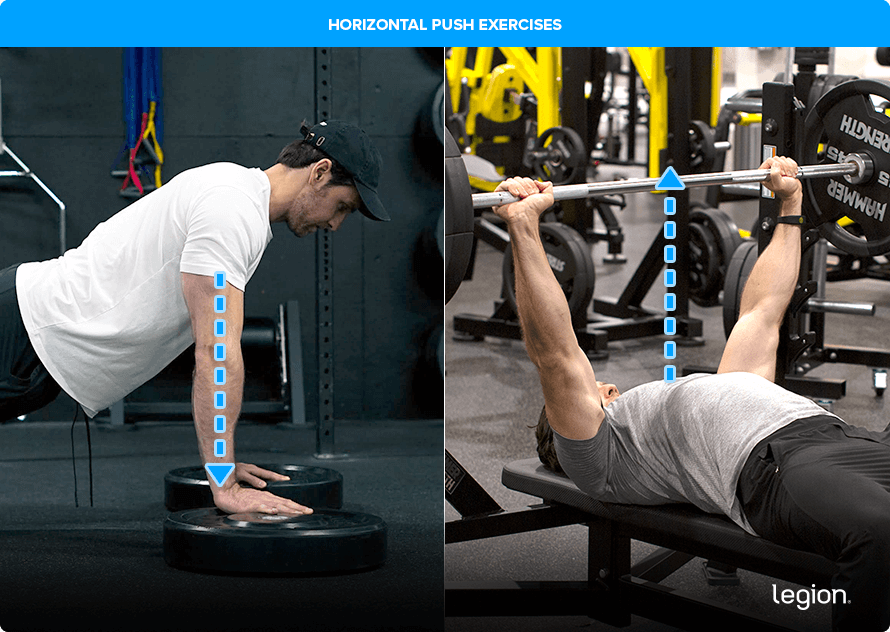
Some people also consider the leg press a horizontal push exercise since your legs press horizontally. While that’s not entirely wrong, I think it muddies the definition and can be confusing, especially for new weightlifters.
That’s why, for clarity, this article will focus exclusively on upper body horizontal push exercises.
What Muscles Do Horizontal Presses Work?
When you press horizontally, you train the following muscles:
- Pectorals (pecs)
- Anterior deltoids (front delts)
- Triceps
Here’s how these muscle look on your body:
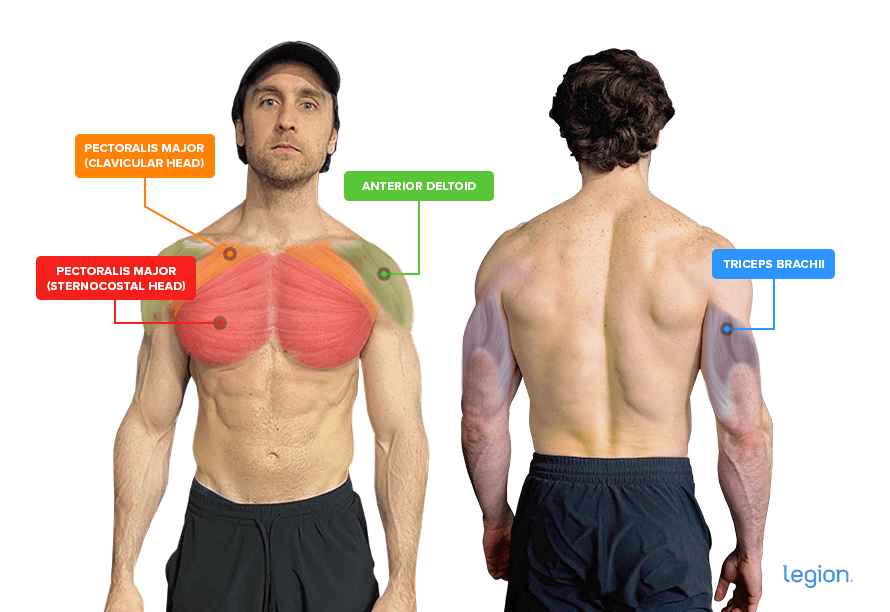
Horizontal press exercises also train many other stabilizer muscles throughout your body, namely the side delts, lats, traps, serratus anterior, and biceps.
The 8 Best Horizontal Push Exercises for Chest Mass & Strength
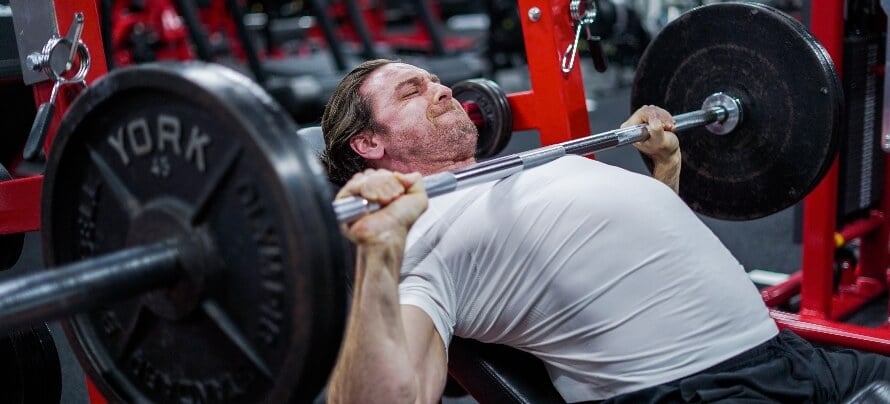
While some “experts” claim you need a wide variety of horizontal pushing movements to see results, that’s simply not true.
In reality, just a few key exercises are all you need—ones that allow you to lift heavy weights safely, train through a full range of motion, and consistently gain strength.
Add the following to your routine, and you’ll see big growth in your chest, shoulders, and triceps.
1. Barbell Bench Press
Why: When it comes to horizontal push exercises, the barbell bench press is unbeatable. It trains all the major upper body “pressing muscles” and lets you lift heavy weights safely. That’s why you’ll find it as the first exercise in just about every great horizontal press workout.
How to:
- Lie on a flat bench and place your feet flat on the floor.
- Pull your shoulder blades together and down, and without lifting your butt or shoulders off the bench, slightly arch your back.
- Grab the bar with a slightly wider than shoulder-width grip and unrack the barbell.
- Lower the barbell to your chest, keeping your elbows tucked 6-to-8 inches from your sides.
- Press the bar back to the starting position.
2. Incline Barbell Bench Press
Why: The incline barbell bench press is a staple in most chest-building routines because it’s the best way to target your “upper chest.” No other exercise that involves pressing horizontally engages this area as effectively, so it’s crucial for building a full, well-rounded chest.
How to:
- Lie on a bench angled at 30-to-45 degrees and plant your feet on the floor.
- Pull your shoulder blades together and down, and without lifting your butt or shoulders off the bench, slightly arch your back.
- Grab the bar with a slightly wider than shoulder-width grip and unrack the barbell.
- Lower the barbell to your upper chest, keeping your elbows tucked 6-to-8 inches from your sides.
- Press the bar back to the starting position.
3. Dumbbell Bench Press
Why: The dumbbell bench press trains all your pushing muscles while allowing each side of your body to move independently, which helps develop balanced, symmetrical mass. It also trains your pecs through a slightly longer range of motion than barbell presses, which may further benefit growth.
How to:
- While sitting on a flat bench, hold a dumbbell in each hand and rest them on your thighs.
- Lie back and bring the dumbbells up so you’re holding them on either side of your chest by giving them a nudge with your thighs.
- Press the dumbbells over your chest until your arms are straight and your elbows are locked.
- Lower the dumbbells to the starting position.
4. Incline Dumbbell Bench Press
Why: The incline dumbbell bench press is one of the most effective horizontal press exercises for building your upper pecs and creating a chest that looks full and well-proportioned from every angle.
How to:
- While lying on a bench angled at 30-to-45 degrees, hold a dumbbell in each hand and rest them on your thighs.
- Lie back, hoisting the dumbbells up so you’re holding them on either side of your chest by giving them a nudge with your thighs.
- Press the dumbbells over your upper chest until your arms are straight and your elbows are locked.
- Lower the dumbbells to the starting position.
5. Close-Grip Bench Press
Why: While many view the close-grip bench press as a triceps exercise, it’s also great for training your pecs, particularly the upper portion. Using a narrower grip and tucking your elbows also makes it more shoulder-friendly compared to other horizontal push exercises.
How to:
- Lie on a flat bench and place your feet flat on the floor.
- Pull your shoulder blades together and down, and without lifting your butt or shoulders off the bench, slightly arch your back.
- Grip the barbell with a shoulder-width grip or slightly narrower and unrack the barbell.
- Lower the barbell to your lower chest, keeping your elbows tucked 2-to-4 inches from your sides.
- Press the bar back to the starting position.
6. Dip
Why: The dip deeply stretches your pecs and trains them through a full range of motion, which likely benefits muscle growth. It may also target the lower pecs more effectively than other horizontal push exercises, making it valuable for rounding out your chest development.
How to:
- If you’re using a dip belt, wrap the chain around your waist, add the desired amount of weight to the chain, and fasten the carabiner.
- Grab both handles of a dip station, then press yourself up by straightening your arms and gently jumping off the ground so your arms are straight and supporting your entire body weight.
- Slightly bend your knees to keep your feet from touching the ground, then lower your body by bending your elbows until your upper arms are roughly parallel to the floor.
- Reverse the movement and return to the starting position.
7. Horizontal Chest Press Machine
Why: The horizontal chest press machine is one of the easiest pressing exercises to learn, making it a great choice for beginners who are still mastering proper pressing technique. For more experienced lifters, it’s also ideal for adding extra chest volume (sets) toward the end of a workout, when lifting heavy free weights might be too taxing.
How to:
- Adjust the chest press machine handles and seat so the handles are in line with your shoulders and just a few inches from your chest.
- Grip both handles with your palms facing down and press forward until your arms are straight.
- Reverse the movement and return to the starting position.
8. Push-up
Why: The push-up is a fundamental horizontal push exercise you can perform anywhere without equipment, making it incredibly versatile. Plus, it’s easy to modify—whether you’re a beginner and want to make it easier by doing it on your knees, or advanced and want to make it more challenging by elevating your feet or hands.
How to:
- Get on all fours and place your hands slightly wider than shoulder-width apart.
- Extend your legs behind you so you support your body weight on your hands and toes, and your body forms a straight line from your head to your feet.
- Lower your chest to the floor by bending your elbows, then push your body up and return to the starting position.
Example Horizontal Press Workouts
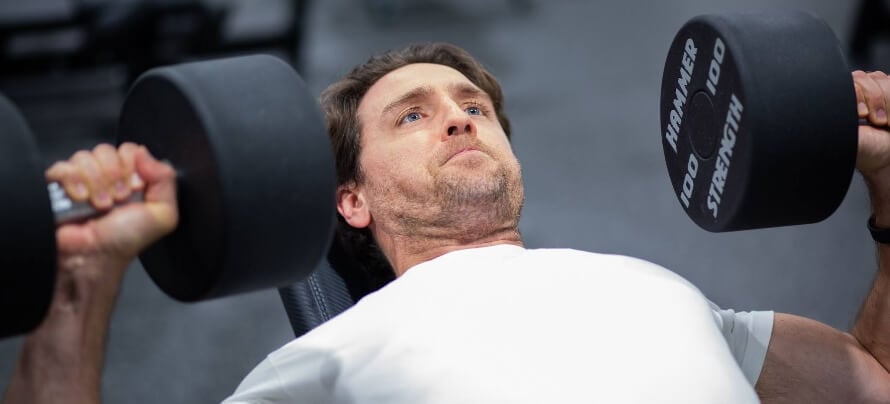
You now know the best horizontal push exercises for targeting your pecs, shoulders, and triceps. Next, let’s dive into how to structure these exercises into effective, mass-building workouts.
For optimal results, keep these key principles in mind when planning your horizontal press workouts:
- Do a mix of compound exercises that train your pushing muscles at different angles and through varying ranges of motion.
- Finish your workouts with a triceps isolation exercise that emphasizes the long head, since this part of the triceps get’s little stimulus from horizontal pressing.
The following two workouts meet these criteria perfectly. They also contain the ideal amount of sets to build muscle without wearing you out.
Here’s how to incorporate them into your training:
Perform Horizontal Push Workout #1 once a week for 8-to-10 weeks as part of a well-designed program. Then, take a deload and switch to Horizontal Push Workout #2 for the next 8-to-10 weeks.
You can then continue alternating between these workouts every 8-to-10 weeks, or create your own workouts using the exercises above.
The Legion Horizontal Press Workout #1
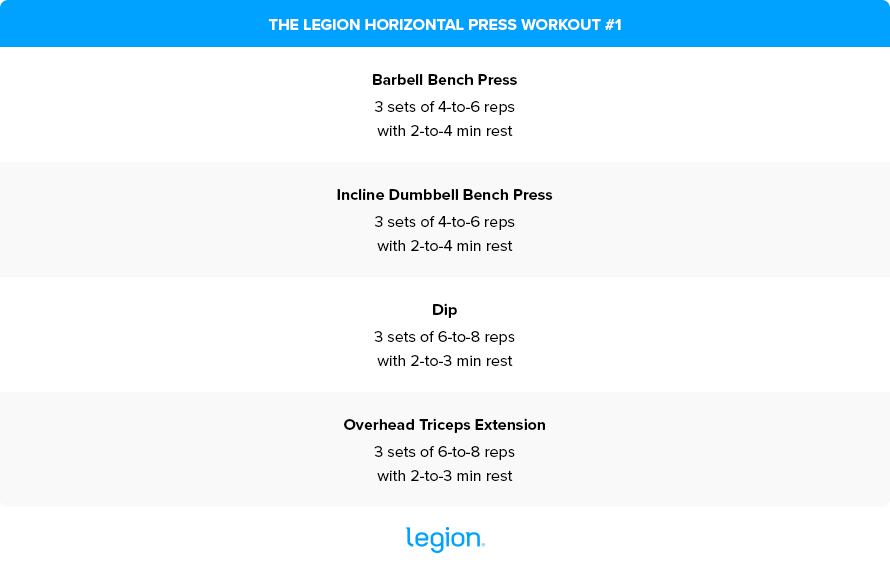
The Legion Horizontal Press Workout #2
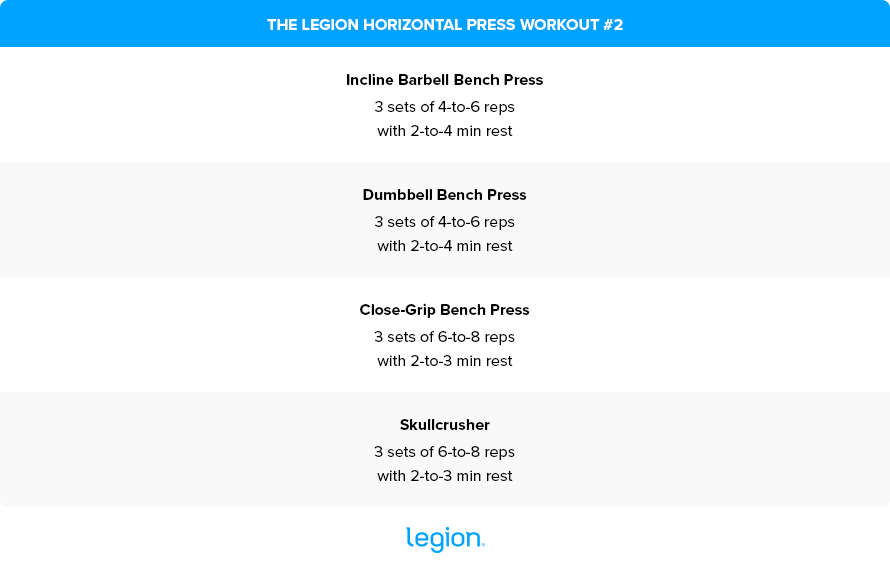
Horizontal Push Exercises: Key Takeaways
Horizontal push exercises are essential for building bigger, stronger pecs, shoulders, and triceps. They also train many other smaller stabilizer muscles throughout your torso, making them excellent for gaining all-around upper body size.
You don’t need a long list of these exercises to see results. These eight movements are enough to add mass and strength to all your pushing muscles:
- Barbell bench press
- Incline barbell bench press
- Dumbbell bench press
- Incline dumbbell bench press
- Close-grip bench press
- Dip
- Horizontal chest press machine
- Push-up
Incorporate these into your workouts, and you’ll soon notice your chest, shoulders, and triceps growing.
FAQ #1: Can you perform horizontal pushing exercises at home?
Yes, you can perform horizontal pushing exercises at home. The exercises you do depend on the equipment you have available.
If you have no equipment, the push-up is your best option. To learn how to adapt it to your fitness level, check out this article:
How to Do the Push-up: Form, Variations, and Workouts
If you have dumbbells but no bench, the dumbbell floor press is a viable alternative to the dumbbell bench press. Here’s how it looks:
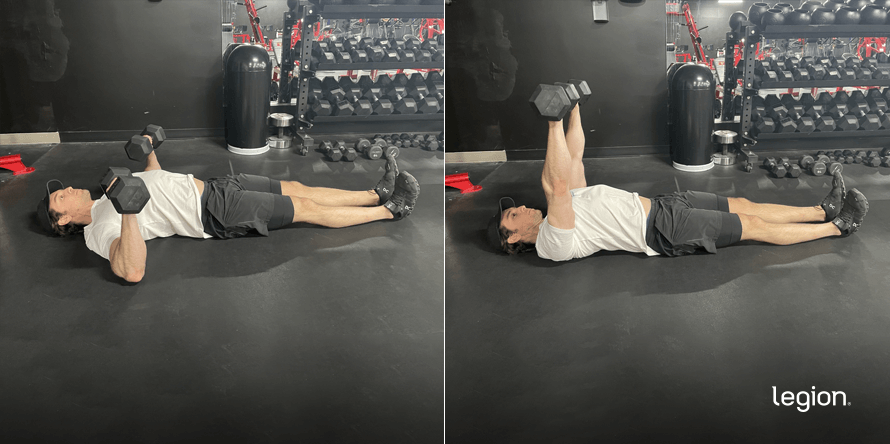
And if you have dumbbells and a bench, you can perform all the dumbbell horizontal push exercises listed above.
FAQ #2: What are the benefits of horizontal pushes?
Horizontal push exercises are excellent for building upper body muscle, particularly in the pecs, shoulders, and triceps. They also allow you to lift heavy weights safely, which makes gaining strength straightforward. Additionally, horizontal presses boost upper-body power, which can enhance athletic performance in sports involving pushing, throwing, or explosive upper-body movements.
FAQ #3: What are the best horizontal push exercises for beginners?
The single best horizontal push exercise for beginners is the push-up because it requires no equipment and you can easily modify it based on your fitness level.
The horizontal chest press machine is another excellent choice, as it’s more straightforward to learn and perform than free-weight exercises that require more coordination.
Barbell exercises, like the flat and incline bench press, are also beginner-friendly. I usually recommend these over dumbbell presses because they’re inherently more stable, which can help beginners focus more on their form without worrying as much about balance.
Scientific References +
- Rodríguez-Ridao, David, et al. “Effect of Five Bench Inclinations on the Electromyographic Activity of the Pectoralis Major, Anterior Deltoid, and Triceps Brachii during the Bench Press Exercise.” International Journal of Environmental Research and Public Health, vol. 17, no. 19, 8 Oct. 2020, p. 7339, https://doi.org/10.3390/ijerph17197339.
- Oranchuk, Dustin J., et al. “Isometric Training and Long-Term Adaptations: Effects of Muscle Length, Intensity, and Intent: A Systematic Review.” Scandinavian Journal of Medicine & Science in Sports, vol. 29, no. 4, 13 Jan. 2019, pp. 484–503, onlinelibrary.wiley.com/doi/full/10.1111/sms.13375, https://doi.org/10.1111/sms.13375.
- “(PDF) Effects of Variations of the Bench Press Exercise on the EMG Activity of Five Shoulder Muscles.” ResearchGate, www.researchgate.net/publication/232217991_Effects_of_Variations_of_the_Bench_Press_Exercise_on_the_EMG_Activity_of_Five_Shoulder_Muscles.
- Wolf, Milo, et al. “Does Longer-Muscle Length Resistance Training Cause Greater Longitudinal Growth in Humans? A Systematic Review.” Sportrxiv.org, 17 June 2024, sportrxiv.org/index.php/server/preprint/view/423/version/539. Accessed 24 June 2024.
- Schoenfeld, Brad J. “The Mechanisms of Muscle Hypertrophy and Their Application to Resistance Training.” Journal of Strength and Conditioning Research, vol. 24, no. 10, Oct. 2010, pp. 2857–72.
- López-Laval, Isaac, et al. “Relationship between Bench Press Strength and Punch Performance in Male Professional Boxers.” Journal of Strength and Conditioning Research, Aug. 2019, p. 1, https://doi.org/10.1519/jsc.0000000000003362.










